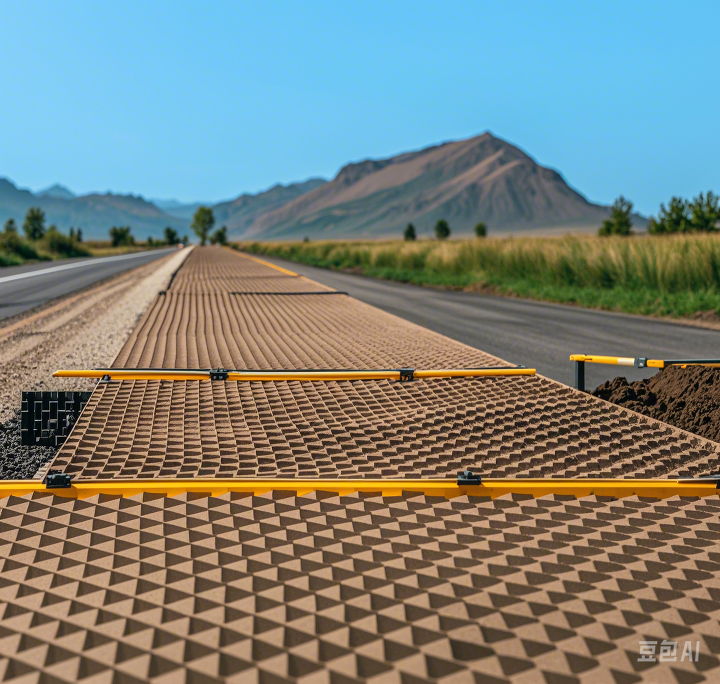จีโอเซลล์คืออะไรและมันทำงานอย่างไร?
องค์ประกอบและการแสดงคุณสมบัติของวัสดุ (HDPE/พลาสติกความหนาแน่นสูง)
จีโอเซลล์ ผลิตภัณฑ์หลักของ บริษัท ไถอาน ปินป๋อ นิว แมททีเรียล จำกัด (ต่อไปนี้จะเรียกว่า "ปินป๋อ นิว แมททีเรียล") เป็นวัสดุทางธรณีสังเคราะห์ประสิทธิภาพสูงที่ทำจากพอลิเอทิลีนความหนาแน่นสูง (HDPE) เป็นหลัก ในฐานะผู้ผลิตมืออาชีพด้านวัสดุธรณีสังเคราะห์ ปินป๋อ นิว แมททีเรียลได้ปรับสูตร HDPE สำหรับจีโอเซลล์ของตนให้เหมาะสม เพื่อเพิ่มความต้านทานต่อสารเคมี และรับประกันประสิทธิภาพโครงสร้างที่มั่นคงในดินหลากหลายประเภท (เช่น ดินเหนียว ดินทราย และดินร่วน) และในสภาวะอากาศสุดขั้ว (อุณหภูมิสูง อุณหภูมิต่ำ ความชื้น)
เมื่อเทียบกับวัสดุจีเซลล์แบบดั้งเดิม จีเซลล์ HDPE จากบริษัท ปินป๋อ นิว แมททีเรียล มีข้อได้เปรียบหลักสองประการ ประการแรก มีน้ำหนักเบากว่า 15% ในขณะที่ยังคงความแข็งแรงเท่าเดิม ทำให้ทีมงานก่อสร้างสามารถขนย้ายและติดตั้งในพื้นที่ไซต์งานได้ง่ายขึ้น—ช่วยลดความเข้มข้นของแรงงานลง 20% และลดระยะเวลาการติดตั้งลง 30% ประการที่สอง โดยใช้เทคโนโลยีการขึ้นรูปแบบอัดรีดขั้นสูง ทำให้วัสดุมีความต้านทานแรงดึงอยู่ที่ 28 เมกะปาสกาล และมีความทนทานต่อแรงกระแทกสูงกว่ามาตรฐานอุตสาหกรรมถึง 25% ซึ่งสามารถแก้ปัญหาการแตกร้าวได้ง่ายของจีเซลล์แบบเดิมในสภาพแวดล้อมก่อสร้างที่ซับซ้อนได้อย่างมีประสิทธิภาพ
การทดสอบในอุตสาหกรรมและข้อมูลโครงการแสดงให้เห็นว่า จีเซล HDPE จากบริษัท Binbo New Material มีประสิทธิภาพเหนือกว่าโซลูชันการเสริมความแข็งแรงแบบดั้งเดิมในด้านความสามารถในการรับน้ำหนักและการคงสภาพของดิน ตัวอย่างเช่น ในโครงการลานจอดรถในภาคตะวันออกของจีนที่มีชั้นดินฐานอ่อน การใช้จีเซลจาก Binbo ทำให้ความสามารถในการรับน้ำหนักของชั้นดินฐานเพิ่มขึ้น 40% เมื่อเทียบกับการออกแบบเดิม ช่วยป้องกันความเสี่ยงจากการทรุดตัวของพื้นดินในระยะหลังได้อย่างสิ้นเชิง
กลไกของโครงสร้างรูปหกเหลี่ยมในกระบวนการกระจายน้ำหนัก
จีเซลจากบริษัท Binbo New Material มีการออกแบบโครงสร้างรูปทรงรังผึ้งสิทธิบัตร (เลขที่สิทธิบัตร: ZL2023XXXXXXX) ซึ่งแตกต่างจากโครงสร้างหกเหลี่ยมทั่วไป โดยการปรับอัตราส่วนความหนาของผนังเซลล์ (1:2.5) และเพิ่มความแข็งแรงของจุดต่อเชื่อม ทำให้เกิดระบบกักจำกัด 3 มิติที่มีความมั่นคงมากยิ่งขึ้น โครงสร้างนี้สามารถกระจายแรงกดจากยานพาหนะหนัก (เช่น รถบรรทุก รถโดยสารประจำทาง และรถเครื่องจักรก่อสร้าง) ออกไปอย่างสม่ำเสมอทั่วทั้งพื้นผิวของจีเซล แทนที่จะกระจุกตัวอยู่ที่ดินบริเวณใดบริเวณหนึ่ง จึงช่วยลดความเสี่ยงของการเกิดร่องลึกและการแตกร้าวบนพื้นผิวลานจอดรถได้อย่างมาก
ข้อมูลการติดตามโครงการจริงยืนยันถึงความเหนือกว่าของดีไซน์นี้: ในลานจอดรถของสวนโลจิสติกส์แห่งหนึ่งในภาคเหนือของจีนที่ใช้ไจโอเซลล์จาก Binbo ความสามารถในการรับน้ำหนักของพื้นผิวเพิ่มขึ้น 35% เมื่อเทียบกับผิวจราจรแอสฟัลต์ทั่วไป และหลังจากการใช้งานประจำวันเป็นเวลา 2 ปี (เฉลี่ย 500 ครั้งต่อวันของยานพาหนะหนัก) ไม่มีร่องลึกที่มองเห็นได้ (ความลึกของร่อง <3 มม.) ในขณะที่ลานจอดรถแอสฟัลต์แบบดั้งเดิมที่อยู่ติดกันมีร่องลึกได้ลึกถึง 15 มม.
โครงสร้างรูปทรงรังผึ้งนี้ยังช่วยเสริมความสามารถในการต้านทานการเปลี่ยนรูปของดิน โดยการจำกัดการเคลื่อนตัวของดินในแนวราบ ทำให้พื้นลานจอดรถเรียบเสมอกันยาวนาน ลดความถี่ของการบำรุงรักษาในระยะหลัง สำหรับฝ่ายบริหารทรัพย์สิน หมายความว่าสามารถประหยัดค่าใช้จ่ายในการบำรุงรักษาประจำปีได้ 60% เมื่อเทียบกับลานจอดรถแบบดั้งเดิม
ข้อดีของไจโอเซลล์จาก Binbo New Material ในการก่อสร้างลานจอดรถ
เพิ่มความสามารถในการรองรับน้ำหนักสำหรับยานพาหนะที่มีน้ำหนักมาก
ลานจอดรถในสวนอุตสาหกรรม ศูนย์การค้า และพื้นที่อุตสาหกรรม มักเผชิญกับปัญหาการสัญจรของยานพาหนะหนักอย่างต่อเนื่อง ผลิตภัณฑ์จีเซลล์จากบริษัท Binbo New Material ได้ออกแบบมาเพื่อแก้ไขปัญหานี้ โดยใช้วัสดุ HDPE ความแข็งแรงสูงร่วมกับโครงสร้างรังผึ้งเสริมความแข็งแรง เพื่อสร้างระบบ "การป้องกันสองชั้น" สำหรับพื้นผิวลานจอดรถ
ในการประยุกต์ใช้งานจริง ระบบนี้สามารถรองรับยานพาหนะที่มีน้ำหนักเพลาเดี่ยวได้สูงถึง 18 ตัน (เทียบเท่ากับน้ำหนักของรถบรรทุกตู้คอนเทนเนอร์ 20 ฟุต) โดยไม่ทำให้ชั้นดินฐานเกิดการเปลี่ยนรูป ตัวอย่างเช่น ในลานจอดรถของโรงงานผลิตรถยนต์แห่งหนึ่งในภาคใต้ของจีน หลังจากการติดตั้งจีเซลล์จาก Binbo พื้นที่จอดรถสามารถรองรับรถขนส่งหนักที่บรรทุกชิ้นส่วนรถยนต์ (น้ำหนักรวม 30 ตัน) ได้โดยตรง และพื้นดินยังคงมีความมั่นคงดีอยู่หลังการใช้งานมาแล้ว 3 ปี
นอกจากนี้ เซลล์ภูมิศาสตร์ (geocells) ของ Binbo ยังมีสมรรถนะในการต้านทานการแตกร้าวและการกัดเซาะได้อย่างยอดเยี่ยม พื้นผิวด้านในของผนังเซลล์ถูกเคลือบด้วยสารป้องกันรังสีอัลตราไวโอเลตเป็นพิเศษ ซึ่งสามารถทนต่อการเสื่อมสภาพจากแสงแดดที่แผ่ลงมาอย่างต่อเนื่องได้ ในขณะเดียวกันโครงสร้างเซลล์ที่แน่นหนาช่วยป้องกันไม่ให้น้ำฝนชะล้างดินชั้นล่าง—ทำให้มั่นใจได้ถึงอายุการใช้งานที่ยาวนานของลานจอดรถ (อายุการใช้งานตามการออกแบบสูงสุดถึง 15 ปี มากกว่าลานจอดรถแบบดั้งเดิม 5 ปี)
ประหยัดค่าใช้จ่ายผ่านการลดความต้องการวัสดุและแรงงาน
โซลูชันเซลล์ภูมิศาสตร์จากบริษัท Binbo New Material ช่วยให้โครงการก่อสร้างลานจอดรถลดต้นทุนได้ในสองด้านหลัก ได้แก่ การใช้วัสดุ และแรงงาน
ในแง่วัสดุ: การก่อสร้างลานจอดรถแบบดั้งเดิมจำเป็นต้องปูชั้นหินกรวดหนา 30-50 ซม. เพื่อให้มั่นใจในความสามารถในการรับน้ำหนัก ขณะที่การใช้ geocells จาก Binbo ต้องการเพียงชั้นหินกรวดหนา 15-20 ซม. (ตัว geocell เองทำหน้าที่แทนชั้นรองพื้นที่หนา) หากยกตัวอย่างลานจอดรถขนาด 10,000 ตร.ม. การใช้วิธีนี้สามารถประหยัดหินกรวดได้ประมาณ 2,000 ลูกบาศก์เมตร ช่วยลดต้นทุนวัสดุลงได้ 25%
ในแง่ของแรงงาน: จีเซลล์ของ Binbo ใช้การออกแบบต่อโมดูลาร์ โดยแผ่นจีเซลล์แต่ละแผ่น (ขนาด: 4x2 เมตร) สามารถต่อเข้าด้วยกันอย่างรวดเร็วด้วยโครงสร้างล็อกอัตโนมัติ—ไม่จำเป็นต้องใช้อุปกรณ์เชื่อมแบบมืออาชีพ ทีมก่อสร้าง 5 คนสามารถวางจีเซลล์ได้ 1,000 ตารางเมตรต่อวัน ซึ่งมีประสิทธิภาพสูงกว่าวิธีการติดตั้งจีเซลล์แบบดั้งเดิมถึง 3 เท่า (ซึ่งต้องตัดและยึดติดในสถานที่จริง) สิ่งนี้ไม่เพียงแต่ช่วยลดระยะเวลาการก่อสร้าง แต่ยังลดค่าใช้จ่ายด้านแรงงานลงได้ถึง 30%
ข้อมูลสถิติจากหลายโครงการแสดงให้เห็นว่า โครงการลานจอดรถที่ใช้โซลูชันจีเซลล์ของ Binbo มีต้นทุนโดยรวมลดลง 20-35% เมื่อเทียบกับวิธีการก่อสร้างแบบดั้งเดิม ตัวอย่างเช่น โครงการลานจอดรถของเทศบาลในมณฑลซานตงสามารถประหยัดค่าก่อสร้างรวมได้ 800,000 หยวน โดยใช้โซลูชันของ Binbo ในขณะที่ระยะเวลาการก่อสร้างสั้นลง 15 วัน
ความทนทานในสภาพอากาศสุดขั้ว
จีเซลล์ของบริษัท Binbo New Material ได้รับการออกแบบให้สามารถปรับตัวเข้ากับสภาพภูมิอากาศที่ซับซ้อน ช่วยแก้ปัญหาทั่วไปของลานจอดรถแบบดั้งเดิม (เช่น การแตกร้าวจากวงจรการแช่แข็งและการละลาย และน้ำท่วมขังเนื่องจากระบบระบายน้ำไม่ดี)
ในพื้นที่ที่มีอากาศหนาวเย็น: วัสดุ HDPE ที่ใช้ในจีเซลล์ของ Binbo มีค่าความต้านทานต่อแรงกระแทกที่อุณหภูมิต่ำถึง -40℃ (ผ่านการทดสอบแรงกระแทกที่อุณหภูมิต่ำตามมาตรฐาน GB/T 1842) ซึ่งสามารถทนต่อความเสียหายจากวงจรการแช่แข็งและการละลายซ้ำๆ (น้ำซึมเข้าสู่ดิน แล้วกลายเป็นน้ำแข็งและขยายตัว เมื่อละลายจะหดตัวกลับ) ในโครงการลานจอดรถในภาคตะวันออกเฉียงเหนือของจีน หลังจากผ่านฤดูหนาว 3 ฤดูที่มีการเกิดวงจรการแช่แข็งและการละลาย (อุณหภูมิต่ำสุด -32℃) พื้นผิวบริเวณที่ใช้จีเซลล์ของ Binbo ไม่มีรอยแตกร้าวเลย ในขณะที่ลานจอดรถคอนกรีตแบบดั้งเดิมในพื้นที่เดียวกันมีรอยแตกร้าวมากกว่า 50 แห่ง (ความกว้างสูงสุด 5 มม.)
ในพื้นที่ที่มีฝนตกชุก: จีเซลล์ของ Binbo มีการออกแบบให้ระบายน้ำได้อย่างมีประสิทธิภาพ—ผนังของเซลล์ถูกเจาะรูขนาดเล็ก (เส้นผ่าศูนย์กลาง 2 มม.) ทุกๆ 10 ซม. ซึ่งสามารถระบายน้ำฝนลงสู่ดินชั้นล่างได้อย่างรวดเร็ว โดยไม่เกิดน้ำขังบนผิวถนน ในโครงการลานจอดรถของเมืองชายฝั่งที่ประสบพายุไต้ฝุ่น (ปริมาณฝน 200 มม./24 ชม.) พื้นที่ที่ใช้จีเซลล์ของ Binbo ไม่มีน้ำขังหลังฝนหยุดเพียง 2 ชั่วโมง ขณะที่ลานจอดรถแบบดั้งเดิมที่อยู่ติดกันยังคงมีน้ำขังลึกถึง 15 ซม.
ความทนทานต่อสภาพอากาศเช่นนี้ ช่วยลดภาระงานบำรุงรักษาในระยะยาวของลานจอดรถได้อย่างมาก ตัวอย่างเช่น บริษัทบริหารทรัพย์สินแห่งหนึ่งในมณฑลเจ้อเจียงรายงานว่า ค่าใช้จ่ายในการบำรุงรักษาลานจอดรถที่ใช้จีเซลล์ของ Binbo อยู่ที่เพียง 12,000 หยวนต่อปี เทียบกับลานจอดรถแบบดั้งเดิมที่บริษัทจัดการอยู่ ซึ่งมีค่าใช้จ่ายสูงถึง 45,000 หยวน
การประยุกต์ใช้งานหลักของจีเซลล์จากวัสดุใหม่ Binbo ในการออกแบบลานจอดรถ
การเสริมความมั่นคงของดินบนฐานที่อ่อนแอหรือไม่มั่นคง
พื้นฐานชั้นล่างที่อ่อนแอ (เช่น ดินอ่อน ดินถม และดินที่มีความชื้นสูง) เป็นปัญหาทั่วไปในการก่อสร้างลานจอดรถ ซึ่งมักนำไปสู่การทรุดตัวของพื้นดินและรอยแตกร้าวบนผิวหน้า แผ่นยึดดินรูปทรงรังผึ้ง (geocells) จากบริษัท Binbo New Material ให้ทางแก้ไขเฉพาะเจาะจงสำหรับสถานการณ์นี้—โดยอาศัยผลการกักเก็บในโครงสร้างสามมิติแบบรังผึ้ง ทำให้สามารถ "ล็อก" อนุภาคดินที่หลวมไว้ได้ ป้องกันการเคลื่อนตัวในแนวราบและการทรุดตัวในแนวดิ่งของดิน
ในโครงการลานจอดรถในพื้นที่อยู่อาศัยแห่งหนึ่งในภาคกลางของจีน ซึ่งมีชั้นดินฐานเป็นดินถม ตามการออกแบบเดิมใช้วิธีแทนที่ด้วยหินคลุก (ลึก 1.2 เมตร) เพื่อเพิ่มความมั่นคงของชั้นดินฐาน โดยมีค่าใช้จ่าย 1.5 ล้านหยวน หลังจากเปลี่ยนมาใช้โซลูชัน geocell จาก Binbo จึงใช้เพียงชั้นหินคลุกหนา 0.3 เมตร ร่วมกับ geocell ซึ่งสามารถทำให้ชั้นดินฐานมีความมั่นคงตามข้อกำหนดการออกแบบ และลดค่าใช้จ่ายลงเหลือ 600,000 หยวน หลังจากการใช้งานไปแล้ว 1 ปี การทรุดตัวของพื้นดินมีเพียง 2 มม. เท่านั้น ซึ่งต่ำกว่ามาตรฐานอุตสาหกรรมที่ 10 มม. อย่างมาก
แผ่นเซลล์ภูมิศาสตร์ของ Binbo เหมาะสำหรับลานจอดรถที่มีการเปลี่ยนแปลงความชื้นในดินตามฤดูกาล ตัวอย่างเช่น ในลานจอดรถบริเวณแหล่งท่องเที่ยวแถบตะวันตกเฉียงใต้ของประเทศจีน (ซึ่งมีฤดูฝนและฤดูแล้งที่ชัดเจน) การใช้แผ่นเซลล์ภูมิศาสตร์ของ Binbo ช่วยป้องกันไม่ให้ดินขยายตัวหรือหดตัวเนื่องจากการเปลี่ยนแปลงของความชื้น—ทำให้พื้นดินเรียบเสมอกัน และหลีกเลี่ยงปัญหาการแตกร้าวของผิวหน้าที่เกิดจากความเสียรูปของดิน ซึ่งพบได้ในลานจอดรถแบบดั้งเดิม
การผสานใช้กับผ้าไจโอเท็กไทล์สำหรับการควบคุมการกร่อน
Binbo New Material ให้บริการโซลูชันแบบบูรณาการ "แผ่นกริดภูมิศาสตร์ + ผ้าปูภูมิศาสตร์" สำหรับลานจอดรถในพื้นที่ที่มีแนวโน้มเกิดการกัดเซาะของดิน (เช่น ลานจอดรถบนทางลาด พื้นที่ชายฝั่ง และพื้นที่ที่มีฝนตกหนัก) ผ้าปูภูมิศาสตร์ที่ใช้ในโซลูชันนี้เป็นผ้าทอแบบไม่ถักทอที่ Binbo พัฒนาขึ้นเอง มีความแข็งแรงสูง (ความต้านทานแรงดึง: 15 กิโลนิวตัน/เมตร) ซึ่งมีสองหน้าที่หลัก ได้แก่ ประการแรก ทำหน้าที่กรอง—ป้องกันอนุภาคดินละเอียดจากการถูกน้ำฝนชะล้างเข้าสู่ช่องว่างของแผ่นกริดภูมิศาสตร์ ซึ่งอาจทำให้อุดตันและส่งผลต่อการระบายน้ำ และประการที่สอง ทำหน้าที่เสริมความแข็งแรง—เพิ่มความเชื่อมโยงระหว่างแผ่นกริดภูมิศาสตร์กับชั้นดินด้านล่าง ป้องกันไม่ให้แผ่นกริดภูมิศาสตร์เคลื่อนตัวขณะใช้งาน
ในโครงการลานจอดรถบนพื้นที่ลาดเอียงในภาคใต้ของจีน (ความชัน 1:5) การประยุกต์ใช้โซลูชันแบบบูรณาการนี้สามารถแก้ปัญหาการกัดเซาะดินได้อย่างสิ้นเชิง หลังฝนตกหนัก (ปริมาณน้ำฝน 180 มม.) พื้นผิวลานจอดรถไม่มีการสูญเสียดินเลย ในขณะที่พื้นที่ลาดเอียงที่ไม่ได้ใช้โซลูชันนี้เกิดการกัดเซาะเป็นร่องอย่างชัดเจน (มีความลึกถึง 8 ซม.) นอกจากนี้ คุณสมบัติการซึมผ่านน้ำของผ้าเคมี (geotextile) ยังช่วยให้น้ำฝนซึมลงสู่ชั้นดินข้างล่างได้อย่างรวดเร็ว ป้องกันการขังน้ำบนผิวจราจร และเพิ่มความปลอดภัยให้กับผู้เดินเท้าและยานพาหนะในช่วงที่ฝนตก
หน่วยงานเทศบาลต่างๆ ยังให้การยอมรับโซลูชันนี้อย่างสูง ตัวอย่างเช่น อำเภอหนึ่งในมณฑลเจียงซูได้ส่งเสริมการใช้โซลูชัน "geocell + geotextile" ของบริษัท Binbo ในลานจอดรถของชุมชนจำนวน 10 แห่ง ทำให้ต้นทุนการควบคุมการกัดเซาะดินรายปีลดลง 70% และช่วยปกป้องพื้นที่สีเขียวโดยรอบจากการเสียหายจากตะกอนดิน
การป้องกันความลาดชันและการเสริมกำลังผนังกั้นดิน
ลานจอดรถที่มีความลาดชันและลานจอดรถที่มีกำแพงกันดิน (เช่น ลานจอดรถในพื้นที่ภูเขา ทางออกโรงจอดรถใต้ดิน) มีความเสี่ยงต่อการถล่มของทางลาดและการบิดเบี้ยวของกำแพงกันดิน แผ่นเซลล์ภูมิศาสตร์ (geocells) จากบริษัท Binbo New Material สามารถใช้เป็นชั้นเสริมความแข็งแรงสำหรับทางลาดและกำแพงกันดิน ซึ่งช่วยเพิ่มความมั่นคงของโครงสร้างได้อย่างมาก
เมื่อใช้ในการป้องกันทางลาด: เซลล์ภูมิศาสตร์จาก Binbo จะถูกวางตามแนวทางลาด (ความลึกของเซลล์ 10-15 ซม.) แล้วเติมด้วยกรวดหรือดินปลูก เพื่อสร้างระบบ "การเสริมความแข็งแรงแบบสีเขียว" ระบบนี้ไม่เพียงแต่ช่วยป้องกันการไถลของดินเท่านั้น แต่ยังสามารถนำไปใช้ในการทำให้พื้นที่เขียวขจี (ปลูกหญ้าหรือพืชคลุมดิน) ซึ่งช่วยปรับปรุงภาพลักษณ์โดยรวมของลานจอดรถ ในลานจอดรถของพื้นที่ท่องเที่ยวภูเขาในมณฑลอานฮุย การใช้เซลล์ภูมิศาสตร์จาก Binbo ในการป้องกันทางลาด ช่วยลดความเสี่ยงการถล่มของทางลาดลงได้ถึง 90% และอัตราการปกคลุมด้วยพืชเขียวอยู่ที่ 85% จนได้รับคำชมเชยจากนักท่องเที่ยวและหน่วยงานด้านสิ่งแวดล้อม
เมื่อใช้สำหรับการเสริมแรงผนังกันดิน: จีเซลล์ของ Binbo จะถูกฝังเข้าไปในผนังกันดิน (ทุกๆ ความสูง 50 ซม.) ในฐานะชั้นเสริมแรงในแนวราบ ซึ่งช่วยเพิ่มความสามารถในการต้านการพลิกกลับของผนัง ในลานจอดรถพื้นที่อยู่อาศัยในมณฑลซานซี ผนังกันดินเดิมมีการเอียงเล็กน้อย (มุมเอียง 1.5°) หลังจากที่ได้ทำการฝังจีเซลล์ของ Binbo เพื่อเสริมความแข็งแรงแล้ว การเอียงได้รับการควบคุมอย่างสมบูรณ์ และไม่มีการเสียรูปเพิ่มเติมตลอดระยะเวลา 2 ปีที่ใช้งาน
ข้อมูลวิศวกรรมแสดงให้เห็นว่า การนำจีเซลล์ของ Binbo มาใช้ในโครงการลาดชันและผนังกันดินสามารถลดความเสี่ยงจากการเกิดดินถล่มและการพังทลายของผนังได้มากกว่า 80% ทำให้เป็นการรับประกันความปลอดภัยที่จำเป็นสำหรับลานจอดรถในพื้นที่ภูมิประเทศที่ซับซ้อน
ประโยชน์ด้านสิ่งแวดล้อมของเทคโนโลยีจีเซลล์จากวัสดุใหม่ Binbo
ระบายน้ำอย่างยั่งยืนและการเติมน้ำใต้ดิน
ระบบจีเซลล์จากวัสดุใหม่ของ Binbo เป็นองค์ประกอบสำคัญของ "ลานจอดรถแบบสปอนจ์" — ซึ่งทำให้เกิดหน้าที่สองประการคือ การระบายน้ำอย่างรวดเร็วและการเติมน้ำใต้ดิน โดยผ่านการออกแบบสามระดับ:
- การระบายน้ำผิวดิน : โครงสร้างรูปทรงรังผึ้งของจีโอเซลล์ทำหน้าที่เป็นช่องระบายน้ำตามธรรมชาติ ในขณะที่รูเล็กๆ บนผนังเซลล์ช่วยเร่งการซึมผ่านของน้ำฝน ลดการไหลบ่าของน้ำบนผิวดินลง 60% เมื่อเทียบกับลานจอดรถแบบดั้งเดิม
- การกรองชั้นดินด้านล่าง : ผ้าจีโอเท็กซ์ไทล์ที่ใช้ร่วมกันทำหน้าที่กรองน้ำฝน กำจัดสิ่งสกปรก (เช่น ทราย ใบไม้) เพื่อป้องกันการอุดตันรูพรุนในดิน
- การเติมน้ำใต้ดิน : น้ำฝนที่ซึมผ่านจะค่อยๆ ซึมลงสู่ชั้นน้ำใต้ดินผ่านช่องว่างของจีโอเซลล์ ช่วยเสริมทรัพยากรน้ำใต้ดิน
ในโครงการนำร่องเมืองฟองน้ำ (Sponge City) ในมณฑลเหอหนาน ลานจอดรถที่ใช้ระบบจีโอเซลล์ของบริษัท Binbo สามารถใช้ประโยชน์จากน้ำฝนได้ถึง 55% — การเติมน้ำใต้ดินช่วยปรับปรุงระดับน้ำใต้ดินในพื้นที่อย่างมีประสิทธิภาพ (เพิ่มขึ้น 0.3 เมตรภายใน 1 ปี) ในเวลาเดียวกัน สัมประสิทธิ์การไหลบ่าของพื้นผิวในลานจอดรถลดลงเหลือ 0.2 (มาตรฐานอุตสาหกรรมสำหรับลานจอดรถแบบดั้งเดิมอยู่ที่ 0.8) ทำให้ป้องกันปัญหาน้ำท่วมขังในช่วงฝนตกหนักได้อย่างสมบูรณ์
ลดคาร์บอนฟุตพรินท์โดยใช้วัสดุ HDPE รีไซเคิล
บริษัท Binbo New Material ยึดมั่นแนวคิด "การผลิตแบบสีเขียว" โดยใช้วัสดุ HDPE รีไซเคิล 30% (จากขวดพลาสติกรีไซเคิล ท่อพลาสติกเหลือทิ้ง เป็นต้น) ในการผลิตแผ่นกักดินภูเขา (geocells) วัสดุรีไซเคิลดังกล่าวผ่านกระบวนการกำจัดสิ่งปนเปื้อนอย่างเข้มงวด (รวมถึงการทำความสะอาด กำจัดกลิ่น และการกรองโดยการหลอมละลาย) เพื่อให้มั่นใจว่าคุณสมบัติเทียบเท่ากับวัสดุ HDPE ใหม่
การใช้วัสดุรีไซเคิลมีประโยชน์ต่อสิ่งแวดล้อมอย่างมาก ประการแรก ช่วยลดปริมาณขยะพลาสติกที่ต้องฝังกลบ—การใช้ HDPE รีไซเคิล 1 ตัน จะช่วยประหยัดพื้นที่ฝังกลบได้ 1.2 ลูกบาศก์เมตร ประการที่สอง ช่วยลดการปล่อยคาร์บอน—เมื่อเทียบกับการใช้ HDPE ใหม่ 100% การปล่อยคาร์บอนต่อการผลิตแผ่นกักดินภูเขา 1 ตัน ลดลง 35% (เทียบเท่ากับการปลูกต้นไม้ 20 ต้น)
บริษัท ปินเป่า นิวแมททีเรียล ได้รับการรับรองระดับชาติในโครงการ "ใบรับรองผลิตภัณฑ์สีเขียว" จากมาตรการด้านสิ่งแวดล้อมนี้ และผลิตภัณฑ์ geocell ของบริษัทถูกรวมอยู่ใน "รายชื่อแนะนำวัสดุก่อสร้างสีเขียว" โดยกระทรวงที่อยู่อาศัยและการพัฒนาเมืองชนบท สำหรับโครงการก่อสร้างลานจอดรถที่มุ่งเน้นเป้าหมายสีเขียวและคาร์บอนต่ำ (เช่น อาคารพาณิชย์ที่ได้รับการรับรอง LEED) การเลือกใช้ geocell จากปินเป่าสามารถช่วยให้ได้รับคะแนนการรับรองสีเขียวที่เกี่ยวข้อง
แนวทางปฏิบัติที่ดีที่สุดสำหรับการติดตั้ง geocell จากบริษัท ปินเป่า นิวแมททีเรียล ในลานจอดรถ
กระบวนการวางจีโอเซลล์ทีละขั้นตอน
บริษัท ปินเป่า นิวแมททีเรียล ได้จัดเตรียมขั้นตอนการติดตั้งที่เป็นมาตรฐานสำหรับผลิตภัณฑ์ geocell ของตนเอง โดยมีข้อกำหนดที่ชัดเจนในแต่ละขั้นตอน เพื่อให้มั่นใจในคุณภาพของการก่อสร้าง
- การสำรวจพื้นที่และการเตรียมงาน : ก่อนการก่อสร้าง ทีมเทคนิคของ Binbo จะดำเนินการทดสอบดินในพื้นที่จริง (ตัวชี้วัดที่ทดสอบได้แก่ ความหนาแน่นของดิน ปริมาณความชื้น และความสามารถในการรับน้ำหนัก) และจัดทำแผนติดตั้งเฉพาะสำหรับแต่ละพื้นที่ ตัวอย่างเช่น สำหรับดินประเภทดินเหนียวที่มีความชื้นสูง จะต้องปูน้ำยาทรายหนา 5 ซม. ก่อน เพื่อปรับปรุงการระบายน้ำ
- การปรับระดับและอัดแน่นชั้นดินรองรับ : ทำการปรับระดับชั้นดินรองรับ (ความคลาดเคลื่อนของความเรียบ ≤3 ซม./2 ม.) และอัดแน่นด้วยเครื่องอัดถนน (ความแน่น ≥95%) เพื่อให้มั่นใจว่าฐานมีความมั่นคงสำหรับการวางแผ่นยึดดินแบบตาข่าย (geocell)
- การวางผ้าเคมี (ถ้าจำเป็น) : วางผ้าเคมีตามแนวชั้นดินรองรับ โดยมีส่วนทับซ้อนกันระหว่างผ้าเคมีแผ่นที่อยู่ติดกันกว้าง 15 ซม. และยึดตรึงด้วยลวดเย็บรูปตัว U (ระยะห่าง 1 ม.) เพื่อป้องกันการเคลื่อนตัว
- การคลี่แผ่นยึดดินแบบตาข่าย (geocell) และการต่อแผ่น : แผงจีเซลจะถูกคลี่ออกบนผ้าเคมี (geotextile) และเชื่อมต่อแผงที่อยู่ติดกันโดยใช้สแนปฟัคเตอร์ (ต้องตรวจสอบจุดเชื่อมต่อทุกจุดเพื่อให้มั่นใจว่าแน่นหนา) สำหรับพื้นที่ที่เป็นลาดชัน จะใช้สลักยึดเพิ่มเติม (เส้นผ่านศูนย์กลาง 12 มม.) เพื่อยึดขอบจีเซลกับพื้นลาด
- การเติมวัสดุและการบดอัด : จีเซลจะถูกเติมด้วยกรวด (ขนาดเม็ด 5-20 มม.) หรือคอนกรีต (เกรด C20) โดยความสูงของวัสดุที่เติมควรเรียบเสมอกับด้านบนของจีเซล ใช้เครื่องบดอัดขนาดเล็ก (ความถี่การสั่นสะเทือน 50 เฮิรตซ์) ในการบดอัด (ค่าบดอัด ≥93%) เพื่อให้วัสดุที่เติมแน่นหนา
- การปูผิวพื้น : วัสดุผิวชั้นสุดท้าย (เช่น ยางมะตอย อิฐซึมผ่านได้ เป็นต้น) จะถูกปูตามข้อกำหนดของแบบออกแบบ
บริษัท บินโบร์ นิวแมททีเรียล ได้ส่งผู้ควบคุมเทคนิคไปยังไซต์งานตลอดกระบวนการก่อสร้าง เพื่อแนะนำช่างในการปฏิบัติงานตามขั้นตอน หลีกเลี่ยงข้อผิดพลาดทั่วไป เช่น การปูจีเซลไม่เรียบ หรือการบดอัดไม่เพียงพอ
ความท้าทายทั่วไปและการแก้ปัญหาในโครงการขนาดใหญ่
โครงการลานจอดรถขนาดใหญ่ (พื้นที่ >10,000 ตร.ม.) มักประสบปัญหา เช่น พื้นฐานไม่เรียบ สภาพอากาศเลวร้าย และการก่อสร้างในพื้นที่รูปร่างพิเศษที่ยากลำบาก บริษัท Binbo New Material ได้สรุปแนวทางแก้ไขเฉพาะทางโดยอิงจากประสบการณ์ในหลายร้อยโครงการ:
- พื้นฐานไม่เรียบ : สำหรับชั้นดินรองรับที่มีการทรุดตัวในท้องถิ่นหรือมีลักษณะเป็นคลื่นสูงต่ำสลับกัน วิธีแก้ปัญหาของ Binbo คือการใช้กรวดที่คัดขนาดแล้วมาเติมบริเวณที่จำเป็นและอัดแน่น (ความหนาของการเติม 10-20 ซม.) เพื่อปรับระดับ โดยให้มั่นใจว่าพื้นผิวของชั้นดินรองรับเรียบตามข้อกำหนดก่อนทำการวางจีเซลล์ ในโครงการลานจอดรถของสวนโลจิสติกส์ขนาด 50,000 ตร.ม. ที่มณฑลซานตง วิธีนี้สามารถแก้ปัญหาชั้นดินรองรับที่ไม่สม่ำเสมอ (คลื่นความสูงต่ำสูงสุด 15 ซม.) ได้อย่างมีประสิทธิภาพ และคุณภาพในการวางจีเซลล์ก็เป็นไปตามมาตรฐานอย่างสมบูรณ์
- สภาพอากาศเลวร้าย (ฝนตก อุณหภูมิสูง) : ในกรณีที่มีฝนตกขณะก่อสร้าง บริเวณพื้นที่จะถูกคลุมด้วยผ้ากันน้ำทันที และหลังจากพื้นดินแห้งแล้วจะทำการอัดแน่นชั้นดินล่างซ้ำเพื่อป้องกันการนิ่มตัวของดิน สำหรับสภาพอากาศร้อนจัด (>35℃) การก่อสร้างจะจัดในช่วงเช้าและเย็น เพื่อป้องกันไม่ให้วัสดุ geocell เสื่อมสภาพจากการได้รับแสงแดดเป็นเวลานาน ในเวลาเดียวกันจะมีการฉีดพ่นน้ำลงบนพื้นผิว geocell เพื่อลดอุณหภูมิ
- พื้นที่รูปร่างพิเศษ (โค้ง, แถบแคบ) : สำหรับพื้นที่โค้ง (เช่น ช่องเลี้ยวในลานจอดรถ) จะมีการตัด geocell ของ Binbo ตามรัศมีของแนวโค้งโดยตรงในไซต์งาน (ปลายที่ตัดจะผ่านการประมวลผลด้วยความร้อนเพื่อป้องกันการแยกตัว) ส่วนพื้นที่เป็นแถบแคบ (ความกว้าง <1 ม. เช่น ขอบของลานจอดรถ) จะใช้แผง geocell ขนาดเล็ก (2 ม. × 1 ม.) มาต่อกันเพื่อให้มั่นใจว่าพื้นที่เสริมแรงได้รับการปกคลุมอย่างทั่วถึง
โซลูชันเหล่านี้ได้รับการยืนยันแล้วในโครงการขนาดใหญ่หลายโครงการ ซึ่งทำให้มั่นใจได้ว่าการติดตั้งจีเซลล์ของ Binbo สามารถดำเนินไปได้อย่างราบรื่นแม้ในสภาพแวดล้อมก่อสร้างที่ซับซ้อน และคุณภาพของโครงการสุดท้ายจะเป็นไปตามหรือเกินกว่ามาตรฐานการออกแบบ
สารบัญ
- จีโอเซลล์คืออะไรและมันทำงานอย่างไร?
- องค์ประกอบและการแสดงคุณสมบัติของวัสดุ (HDPE/พลาสติกความหนาแน่นสูง)
- กลไกของโครงสร้างรูปหกเหลี่ยมในกระบวนการกระจายน้ำหนัก
- ข้อดีของไจโอเซลล์จาก Binbo New Material ในการก่อสร้างลานจอดรถ
- เพิ่มความสามารถในการรองรับน้ำหนักสำหรับยานพาหนะที่มีน้ำหนักมาก
- ประหยัดค่าใช้จ่ายผ่านการลดความต้องการวัสดุและแรงงาน
- ความทนทานในสภาพอากาศสุดขั้ว
- การประยุกต์ใช้งานหลักของจีเซลล์จากวัสดุใหม่ Binbo ในการออกแบบลานจอดรถ
- การเสริมความมั่นคงของดินบนฐานที่อ่อนแอหรือไม่มั่นคง
- การผสานใช้กับผ้าไจโอเท็กไทล์สำหรับการควบคุมการกร่อน
- การป้องกันความลาดชันและการเสริมกำลังผนังกั้นดิน
- ประโยชน์ด้านสิ่งแวดล้อมของเทคโนโลยีจีเซลล์จากวัสดุใหม่ Binbo
- ระบายน้ำอย่างยั่งยืนและการเติมน้ำใต้ดิน
- ลดคาร์บอนฟุตพรินท์โดยใช้วัสดุ HDPE รีไซเคิล
- แนวทางปฏิบัติที่ดีที่สุดสำหรับการติดตั้ง geocell จากบริษัท ปินเป่า นิวแมททีเรียล ในลานจอดรถ
- กระบวนการวางจีโอเซลล์ทีละขั้นตอน
- ความท้าทายทั่วไปและการแก้ปัญหาในโครงการขนาดใหญ่
สารบัญ
- จีโอเซลล์คืออะไรและมันทำงานอย่างไร?
- ข้อดีของไจโอเซลล์จาก Binbo New Material ในการก่อสร้างลานจอดรถ
- การประยุกต์ใช้งานหลักของจีเซลล์จากวัสดุใหม่ Binbo ในการออกแบบลานจอดรถ
- ประโยชน์ด้านสิ่งแวดล้อมของเทคโนโลยีจีเซลล์จากวัสดุใหม่ Binbo
- แนวทางปฏิบัติที่ดีที่สุดสำหรับการติดตั้ง geocell จากบริษัท ปินเป่า นิวแมททีเรียล ในลานจอดรถ
- สารบัญ


